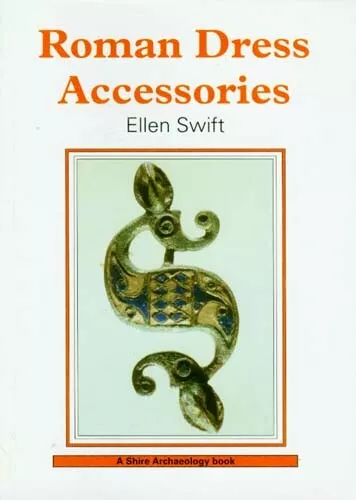Roman Dress Accessories Jewelry Rings Earrings Brooch Fibula Clothing Production
"Roman Dress Accessories (Shire Archaeology)" by Ellen Swift.
NOTE: We have 75,000 books in our library, almost 10,000 different titles. Odds are we have other copies of this same title in varying conditions, some less expensive, some better condition. We might also have different editions as well (some paperback, some hardcover, oftentimes international editions). If you don’t see what you want, please contact us and ask. We’re happy to send you a summary of the differing conditions and prices we may have for the same title.
DESCRIPTION: Softcover. Publisher: Shire Publications (2003). Pages: 56. Size: 8¼ x 6 inches; ½ pound. Summary: This book provides an introduction to Roman dress accessories - defined here as what would today be called costume jewelry (non-precious metal jewelry). Items such as bracelets and pins are widely found in the Roman period in copper alloy, bone, glass, jet, shale and other materials. Completely new objects were introduced by the Romans, spread rapidly in each area of the Empire and were adopted by local populations.
Different styles of Roman object became popular in each succeeding century, as dress fashions changed. Using new evidence from finds, production areas, distribution patterns and the locations of workshops are examined. The interpretation of dress accessories is introduced, with reference to the depiction of objects in Roman art. Brooches, bracelets, beads, necklaces, rings, earrings, pins and belt sets are explained in detail, and the most popular types are described and illustrated, enabling the reader to identify common objects that might be found on an archaeological site or in a museum.
CONDITION: NEW. New oversized softcover. Shire Publications (2003 First Printing) 56 pages. Unblemished, unmarked, pristine in every respect. Pages are pristine; clean, crisp, unmarked, unmutilated, tightly bound, unambiguously unread. Satisfaction unconditionally guaranteed. In stock, ready to ship. No disappointments, no excuses. PROMPT SHIPPING! HEAVILY PADDED, DAMAGE-FREE PACKAGING! Meticulous and accurate descriptions! Selling rare and out-of-print ancient history books on-line since 1997. We accept returns for any reason within 30 days! #6634a.
PLEASE SEE DESCRIPTIONS AND IMAGES BELOW FOR DETAILED REVIEWS AND FOR PAGES OF PICTURES FROM INSIDE OF BOOK.
PLEASE SEE PUBLISHER, PROFESSIONAL, AND READER REVIEWS BELOW.
PUBLISHER REVIEWS:
REVIEW: Ellen Swift is rapidly becoming synonymous with the subject of Roman dress and in this concise study she provides an introduction to what today would be termed costume jewelry. Moving away from high status glitzy jewelry, she focuses on the dress accessories of the everyday person, the brooches, bracelets, finger-rings, earrings, beads, pins and belt sets. Based on archaeological finds, Swift discusses the production of these items, the workshops responsible, and the distribution of particular types which records a discernible shift alongside the process of Romanization. Finally interpretations are made of fashion, of styles of provincial dress, regional variations and the effect of gender and status on Roman dress accessories. Photographs, drawings and maps are found throughout this excellent new study.
REVIEW: Provides an introduction to Roman dress accessories (non-precious metal jewelry). Using evidence from finds, this book examines production areas, distribution patterns and the locations of workshops. It also introduces the interpretation of dress accessories, with reference to the depiction of objects in Roman art.
REVIEW: Fully illustrated and accessible to the non-specialist, this book represents an important contribution to the study of Roman bracelets, brooches, rings, earrings, beads, pins and belt sets. The author explains how to interpret these accessories whether in a museum or at an archaeological site.
REVIEW: This book provides an introduction to what would today be called costume jewelry.
REVIEW: Osprey Publishing (Shire) has been providing books for enthusiasts since 1968 and since then it has grown, evolved and taken on new challenges until it stands today as one of the most successful examples of niche publishing around.
REVIEW: Ellen Swift studied archaeology at the Institute of Archaeology, University College London, and her PhD was awarded in 1999. She has participated in excavations in Britain an abroad and is a member of the Roman Finds Group and of 'Instrumentum' an international association for the study of crafts and manufactured products in antiquity. She is currently Lecturer in Archaeology at the University of Kent, and she has written a book about the end of the Western Roman Empire.
REVIEW:
TABLE OF CONTENTS:
Introduction.
Production Systems and Distribution.
Brooches.
Bracelets.
Finger Rings and Earrings.
Beads.
Pins.
Belt Sets.
Interpreting Dress Accessories.
Further Reading.
Museums.
PROFESSIONAL REVIEWS:
REVIEW: Remarkable introduction to Roman Costume jewelry and fashion accessories.
READER REVIEWS:
REVIEW: This 52 page booklet published by Shire Archaeology does not deal with roman jewelry that was expensive at the time, such as items made of gold or silver; instead it covers more everyday items such as brooches, bracelets, belt buckles, and rings, usually made of bone, jet, glass or cheap metal such as copper.
Most of the text is taken up stating the various categories of each item that archaeologists have broken their finds down into - for example, cross-bow and penannular brooches. This is probably very useful for archaeology students but personally, I did not find that it helped me understand or imagine the Roman period any the more vividly.
There is information about which designs have been found in which part of the Empire, and the probable social meaning of the items. There was also very good information pertaining to the methods of producing glass beads. Unusually for a Shire booklet there are color images, though most of the many illustrations are black and white drawings of the different archetypes.
REVIEW: This is a very good book. It may only be a short volume, but it's a concise typological account of some very important fittings for Roman re-enactors, mainly buckles and brooches. And it dispels a few of the myths that have grown up around the migration period, such as who was Roman and who wasn't.
REVIEW: An easy-to-read introduction to the smaller-but-nonetheless crucial aspects of Roman dress, both within in the empire itself and on/beyond the frontier. For someone like myself who is attempting to write historical fiction about Roman Britain, this is a wonderful reference. I definitely intend to read more of Ellen Swift's books!
REVIEW: Five stars! Great book, excellent reading, marvelous illustrations. Quite informative.
ADDITIONAL BACKGROUND:
REVIEW: Ancient Roman jewelry was characterized by an interest in colored gemstones and glass, contrasting with Greek predecessors, which focused primarily on the production of high-quality metalwork by practiced artisans. Various types of jewelry were worn by different genders and social classes in Rome, and were used both for aesthetic purposes and to communicate social messages of status and wealth.
While much emphasis is placed on fine gold and silver pieces of antiquated jewelry, many pieces worn by lower social classes in Rome would have been made out of bronze or other less expensive metals. Gold and silver pieces would have been worn by the wealthy. Unlike ancient Greek jewelers, Roman manufacturers would have dealt primarily with mass-produced pieces created using molds and casting techniques. This allowed more people to afford such accessories.
Roman aesthetic values led to the increased use of precious and semi-precious gemstones as well as colored glass in jewelry. Ostentatious and creative use of color was valued over fine metalwork. Glass makers were supposedly so skilled that they could fool the public into thinking that glass beads and ornaments were actually gemstones. When genuine gems were utilized, the stones preferred by Roman women were amethyst, emerald, and pearl.
Solid gold snake bracelets, among the most popular types of Roman jewelry. Snake bracelets were often worn in pairs, around the wrists as well as on the upper arms The focus on showiness and imitation of fine materials demonstrates the fact that Romans were highly conscious of how they presented themselves in public. While living, Roman men and women frequently used ornamentation of their houses and bodies to demonstrate wealth, power, influence, and knowledge.
As with many societies, ancient Roman accessorizing varied along boundaries of gender and age, in addition to social standing. Roman women collected and wore more jewelry than men. Women usually had pierced ears, in which they would wear one set of earrings. Additionally they would adorn themselves with necklaces, bracelets, rings, and fibulae. One choker-style necklace, two bracelets, and multiple rings would be worn at once. Jewelry was particularly important to women because it was considered to be their own property, which could be kept independently of their husband's wealth and used as the women saw fit. They had the right to buy, sell, bequeath, or barter their own jewelry.
Typically Roman men wore less jewelry than their female counterparts. Finger rings and fibulae were the most common forms of jewelry worn by men, but they would also sometimes wear pendants. Roman men, unlike Greek men, wore multiple rings at once. Roman children's jewelry served special purposes, especially in the form of amulets. These were worn draped around the neck, and had specialized purposes to protect the children from illness and misfortune. For example, a phallic fascinus was commonly placed on or near a young boy to ward off the evil forces.
Collections of jewelry represented great wealth and power to the Roman owners. The use of this jewelry was not limited to simply wearing it, but also extended to spiritual purposes. Hoards of gold, silver, and bronze jewelry have been found at Greek and Roman temples, providing evidence that worshipers would have offered some of their jewelry to the god or goddess of the temple, much as they would have offered other objects.[Wikipedia].
REVIEW: A major excavation carried out in the ancient city of Aksum in northern Ethiopia has yielded stunning treasures from both the Roman empire and Aksumite kingdom, revealing a connection with the Romans hundreds of years earlier than previously believed. The Guardian reports that the “extraordinary” relics were unearthed in a series of graves dating back to the 1st and 2nd centuries. The artifacts include luxurious items of jewelry, such as a necklace made of thousands of tiny colored-glass beads; a beaded belt, Roman glass vessels, drinking beakers, a flask, clay jug, iron bangles, a glass perfume flask, and a Roman bronze mirror.
The Kingdom of Aksum was a trading nation that flourished between 100 and 940 AD. At its height, the Empire extended across most of present-day Eritrea, northern Ethiopia, Western Yemen, southern Saudi Arabia and Sudan. The capital city of the empire, also called Aksum, was based in what is now northern Ethiopia, and was once a wealthy metropolis, cultural and economic center. Aksum was a major player in the commercial route between the Roman Empire and Ancient India, exporting ivory, tortoise shell, gold and emeralds, and importing silk, spices, and other goods.
The Kingdom of Aksum was ideally placed to trade with both ancient India and the Roman Empire. Historical and archaeological records have shown that the Aksumite Empire was trading with the Romans at least as early as the fourth and fifth centuries. However, the latest discovery shows that trade was occurring much earlier. “Ethiopia is a mysterious place steeped in legend, but nobody knows very much about it,” Louise Schofield, excavation lead, told The Guardian. “We know from the later Aksumite period – the fourth and fifth centuries, when they adopted Christianity – that they were trading very intensely with Rome. But our finds are from much earlier. So it shows that extraordinarily precious things were traveling from the Roman Empire through this region centuries before.”
Schofield describes being “blown away” by the precious grave goods that were unearthed, particularly in one burial belonging to a woman that she named “Sleeping Beauty”. She was found wearing a necklace made up of thousands of beads and a beaded belt, and was accompanied by other relics that suggest she was a person of high status. “She was curled up on her side, with her chin resting on her hand, wearing a beautiful bronze ring. She was buried gazing into an extraordinary Roman bronze mirror. She had next to her a beautiful and incredibly ornate bronze cosmetics spoon with a lump of kohl eyeliner,” Schofield told The Guardian.
In 2012, Schofield discovered an enormous ancient goldmine in northern Ethiopia, together with the ruins of a temple and the site of a battlefield, in the former territory of the legendary Queen of Sheba. Schofield believes it may solve the mystery of where the Queen of Sheba derived her fabled treasures. Aksum is also renowned as being the possible resting place of the Ark of the Covenant. [AncientOrigins.Net].
REVIEW: Archaeologists discovered a hoard of 100 silver items, including coins and jewelry, which come from the 4th and 5th centuries A.D. The treasure belongs to the period of the Roman Empire’s domination in Scotland, or perhaps later. Almost 200 years ago, a team of Scottish laborers cleared a rocky field with dynamite. They discovered three magnificent silver artifacts: a chain, a spiral bangle, and a hand pin. However, they didn't search any deeper to check if there were any more treasures. They turned the field into a farmland and excavations were forgotten.
Now, archaeologists have returned to the site and discovered a hoard (a group of valuable objects that is sometimes purposely buried underground) of 100 silver items. According to Live Science, the treasure is called the Gaulcross hoard. The artifacts belonged to the Pict people who lived in Scotland before, during, and after the Roman era. The artifacts were found by a team led by Gordon Noble, head of archaeology at the University of Aberdeen in Scotland.
When they started work in the field, they didn't think to search for more artifacts, but were trying to learn more about the context of the discovery made nearly two centuries ago. The researchers claim that the field also contained two man-made stone circles - one dating to the Neolithic period and the other the Bronze Age (1670 – 1500 B.C.). The three previously discovered pieces were given to Banff Museum in Aberdeenshire, and are now on loan and display at the National Museum of Scotland in Edinburgh.
In 2013, two groups of researchers studied the field in northeastern Scotland with the help of metal detectors. It was the first time when researchers explored the field after such a long time. During the second day of work, they uncovered three Late-Roman-era silver "siliquae," or coins, that dated to the 4th or 5th century A.D. They also found a part of a silver bracelet, silver strap-end, and several pieces of folded hacksilver (pieces of cut or bent silver). They examined the field over the next 18 months, and as a result, they unearthed 100 pieces of silver all together.
The silver was not mined in Scotland during the Roman period, and instead came from somewhere else in the Roman world. During the "Late Roman period, silver was recycled and recast into high-status objects that underpinned the development of elite society in the post-Roman period". The researchers believe that some of these silver pieces, such as the chunks of silver called ingots, may have served as currency, much as a gold bar did in more modern times. The recent discoveries help shed light on the date of the Gaulcross hoard. It seems that some of the objects were connected with the elites. The silver hand pins and bracelets are very rare finds, so the researchers concluded that the objects would have belonged to some of the most powerful members of the post-Roman society.
Some of the finds from Gaulcross: A) the lunate/crescent-shaped pendant with two Another important hoard has previously been uncovered in Scotland. Actually, on October 13, 2014, April Holloway of Ancient Origins reported on the discovery of one of the most significant Viking hoards found there to date. She wrote: "An amateur treasure hunter equipped with a metal detector has unearthed a massive hoard of Viking artifacts in Dumfries and Galloway, in what has been described as one of the most significant archaeological finds in Scottish history. According to the Herald Scotland , more than 100 Viking relics were found, including silver ingots, armbands, brooches, and gold objects." The findings also included “an early Christian cross from the 9th or 10 century AD made from solid silver, described as having unique and unusual decorations. There was also a rare Carolingian vessel, believed to be the largest Carolingian pot ever discovered.” Holloway wrote that the Vikings “conducted numerous raids on Carolingian lands between 8th and 10th century AD” and explained that in a “few records, the Vikings are thought to have led their first raids in Scotland on the island of Iona in 794.”
The Vikings attacks led to the downfall of the Picts. As Holloway reported: “In 839, a large Norse fleet invaded via the River Tay and River Earn, both of which were highly navigable, and reached into the heart of the Pictish kingdom of Fortriu. They defeated the king of the Picts, and the king of the Scots of Dál Riata, along with many members of the Pictish aristocracy in battle. The sophisticated kingdom that had been built fell apart, as did the Pictish leadership." [AncientOrigins.Net].
REVIEW: Romano-Celtic brooches reflected the complexities of life on Rome's northern frontier, where native Celtic and classical cultures converged. "Dragon" motif brooches with curving animal heads and bright enameling were typical of Celtic art in northern Britain, yet the style dates to a time after the invasion of the country by the Roman emperor Claudius in A.D. 43. Prior to the arrival of the Romans, Celtic brooches were almost universally safety-pin-type. The Celts combined new Roman styles, including animal-shaped and flat brooches, with local styles of decoration familiar from jewelry and horse gear to create a new indigenous type. The "dragonesque" brooches show the hybridization of cultures and the innovation of Celtic art on the edge of the Roman Empire.
Some 250 of these brooches have been found, mostly in the frontier area. But a few were scattered across the Empire, perhaps the property of troops who had served in Britain or souvenirs of visits to the northern frontier. One particular enameled example was unearthed around 1840 was with a hoard of metalwork, which came from a peat bog about 50 miles north of Hadrian's Wall in what is now Scotland. Unfortunately, much of the hoard was lost soon after its discovery. The surviving pieces include a matching pair of safety-pin brooches, two finger rings, and a torque (neck ornament)--probably a jewelry set--and a large number of bronze vessels, both Roman and Celtic in origin. The hoard's deliberate burial in a bog suggests that it was a votive offering, likely made by a local leader. The mixing of artifacts in the hoard and styles on the brooch show how Celts were adapting to the new world of Rome in the frontier areas. [Archaeological Institute of America].
REVIEW: A collection of Roman jewelry, including three gold armlets, a silver chain necklace, two silver bracelets, a silver armlet, four finger rings, a box containing two pairs of gold earrings, and a bag of coins, was discovered during the renovation of a department store in Colchester, Britain’s oldest recorded town. The cache of jewelry had been buried in the floor of a house that had been burned to the ground at the time of the Boudiccan Revolt of A.D. 61, marked by a thick red and black layer of debris over much of the modern city.
According to Philip Crummy, director of the Colchester Archaeological Trust, “our team removed the find undisturbed along with its surrounding soil, so that the individual items could be carefully uncovered and recorded under controlled conditions off site.” In addition, a piece of a human jaw and a shin bone that had been cut with a heavy, sharp weapon were recovered. “We also discovered food that was never eaten on the floor of the room in which the jewelry was found, including dates, figs, wheat, peas, and grain,” Crummy said. The food was probably stored in the room, and was carbonized and preserved by the fire. [Archaeological Institute of America].
REVIEW: The art of the jeweler. Metalsmiths' shops were the training schools for many of the great artists of the Renaissance. Brunelleschi, Botticelli, Verrocchio, Ghi-berti, Pollaiuolo, and Luca della Robbia all were trained as goldsmiths before they embarked upon the higher arts. The goldsmith made silver vases for the dinner tables of cardinals; knights sent sword blades to be mounted in rich hilts; ladies came to have their jewels set; princes needed medals to commemorate their victories; popes and bishops wished to place chased reliquaries on the altars of their patron saints; and men of fashion ordered medallions to wear upon their hats.
Although many materials-including iron-have been used for jewelry, gold is by far the most satisfactory. One could not expect the same results from any other metal, for the durability and the extraordinary ductility and pliancy of gold and its property of being readily drawn out or flattened into wire or leaf of almost infinite fineness have led to its being used for works in which minute-ness and delicacy of execution were required. Gold may be soldered, it may be cast, and any kind of surface, from the rough to the highest possible polish, given to it. It is the best of all metals upon which to enamel.
Gold was easily retrieved from the gravel of river beds, where it was washed from the eroded rocks; hence it is one of the oldest metals known. Unlike most metals, gold does not tarnish on exposure to the air but remains brilliant. Pure gold is too soft for general use, but it can be hardened and toughened by alloying with most of the other metals. Color is one of its important qualities. When the metal is pure, it is nearly the orange-yellow of the solar spectrum. When it contains a little silver, it is pale yellow, or greenish yellow; and when alloyed with a little copper, it takes a reddish tinge-all so effective in varicolored jewelry.
These alloys have an ancient history, electrum, an alloy of gold and silver which assured beautiful hues, having been used by the Egyptians, Greeks, and other ancient peoples. The ancients, from the most remote times, were acquainted with the art of beating gold into thin leaves, and this leaf was used for other purposes besides personal adornment. Gold leaf was used in buildings for gilding wood, and Egyptians, Greeks, and Romans were adepts in applying it. It was no great departure to introduce gilded backgrounds to paintings or figures in mosaic and finally to illuminated manuscripts.
In the use of gold Byzantium went beyond Rome or Athens. When more skill was attained by painters, backgrounds in perspective took the place of those in gold. Early examples of leaf work in this exhibition may be seen in the headdress and jewelry of Queen Shubad's ladies-in-waiting from the excavations of the royal tombs at Ur in Mesopotamia. They date from a period between 3500 and 2800 B.C.
A second step was the cutting of gold leaf into thin strips to make wire. It is still a question whether the art of wire-drawing was known to the ancients. Plaited wire-work, as used in many places and over a wide period of time, is well represented in ancient history. Fusing and soldering are also ancient techniques. Granular work, the soldering of minute grains of gold one beside the other in a line or disposed ornamentally over a surface, was known to the ancient Egyptian jewelers, as well as to the classical, oriental, and barbarian gold-smiths. This traditional technique can be traced through the centuries, splendid granular work of the ancient and modern civilizations being well represented in archaeological finds.
Filigree, the arranging of wires in patterns, usually soldered to a base, is often associated with granular work. The oriental nations, especially the Moors, knew how to execute filigree with rare delicacy and taste, this technique adapting itself particularly to their designs. Embossing and chasing are techniques of widespread use. The relief effect of embossing is produced by various means. A thin pliable sheet of metal may be pressed into molds, between dies, or over stamps, or it may be molded free hand. An excellent example of an embossed gold sheet which was pressed or hammered may be seen in the Greek sword sheath from South Russia. In handwork the sheet of metal is placed against a ground with a yielding surface and the design is raised from the back by a series of punches.
The work of the chaser is closely related to that of the sculptor, the ornament on the face of a casting or an embossed work being finished with chisels or chasing tools. Jewelry was often enriched by stamping, a simple process by which a design is made in depression with a punch., and the gold fixed by heating to redness; and the surface finally burnished. In all countries the work of the lapidary was combined with that of the goldsmith.
Much jewelry depended for its splendor of effect chiefly upon its inlay of brilliantly colored stones, jaspers, agates, lapis lazuli. Much of the commoner kinds of jewelry, such as buckles for the belts of warriors or brooches for the vestments of ecclesiastics too poor to buy silver or gold, were made of bronze, enameled and mercury-gilded. Mercury-gilding is a process of great antiquity. The object was first carefully polished and rubbed with mercury; thin gold was then laid on and pressed down, the mercury being subsequently volatilized, and so forth, or upon colored glass inlays.
The Egyptians and Greeks were incomparable artists in intaglio (cutting concave designs or figures) in gold, and one notes with astonishment the mastery they possessed over the stubborn hard stones, including the sapphire. A Greek gold ring with an intaglio engraving of a girl stretching herself is one of the finest in ancient history. The engraver's art both in cameo and in intaglio attained a high degree of excellence about 500 B.C., which lasted until about the third or fourth century A.D. The classical artists used rich and warm-tinted oriental stones, the increased intercourse with the East after the death of Alexander the Great having a marked influence on the development of the art.
In gem-engraving the ancients used essentially the same principle that is in use today, that is, drilling with a revolving tool. They also used a sapphire or diamond point set in a handle and applied like a graver. In early medieval times gem-engraving was little practiced, but antique cameos were held in peculiar veneration on ac-count of the belief, then universal, in their potency as medicinal charms. With the Renaissance, the art of gem-engraving was revived, and engravers from that time onward have produced results equal to the best ancient work.
Glass in ancient times was so precious that some nations demanded tribute in this fragile material instead of gold. It is said that a citizen invented a method for making malleable glass and was invited to visit the Roman Emperor Tiberius. He brought a vase, which was thrown to the ground but only dented. A hammer again rounded it into shape. Tiberius then asked whether any other man knew the secret of manufacture. The artisan answered no, whereupon the emperor ordered him beheaded.
Glass inlay, widely used from Egyptian times, is often wrongly called enamel. It is not enamel, which, although a vitreous material, is employed in the powdered state and always fused into position by heat, whereas the glass inlay was always cut or molded and cemented into position. This glass inlay is often referred to as paste, which in the modern sense means glass with a high refractive index and high luster employed to imitate the diamond. Good examples of paste may be seen in some eighteenth-century English and French.
For centuries Egypt was the “promised land” of the ancient civilized world, for the Pharaohs had at their disposal enormous stores of gold. The Egyptians excelled in metal-work, especially in gold, and many techniques employed by goldsmiths today can be seen in ancient Egyptian jewelry, particularly for instance the treasure of el LThuin, which was recovered in its entirety and in nearly the same perfect condition in which it had been placed in the tomb; or the jewelry which had once graced the person of the Princess Sit Hathor Yuinet, daughter of King Se'n-Wosret II, who reigned from 1906 to 1887 B.C. and near whose pyramid, at el Lahfin, she was buried.
Her girdle, one of the outstanding pieces of ancient jewelry, is of amethyst beads and hollow gold panther-head ornaments, inside which pellets tinkled whenever the wearer moved. From the same treasure there is the neck-lace with a pectoral of King Se'n-Wosret II. On either side of the pectoral the hawk of the god Horus supports the cartouche of the king and a group of hieroglyphics which signify, "May King Se'n-Wosret II live many hundreds of thousands of years." The pectoral is gold inlaid with lapis lazuli, car-nelian, and turquoise, and the eyes of the shape made of actual flowers, fruits, and leaves, which were presented to guests to wear at banquets and other festivities.
Brilliant color is one of the most attractive characteristics of Egyptian jewelry. It had its origin in the beads, both of semi-precious stones and of faience, which were widely worn during the Old Kingdom (2800-2270 B.C.). Beads of faience of different colors were also in fashion during the XVIII Dynasty. The composition of the broad collars of faience of this period was derived from ornaments of the same engraving, soldering, and metal intaglio.
The Greek jeweler, like the Egyptian, excelled in the arts of embossing and chasing. Greece had little access to precious stones before Alexander's Eastern conquests, and so from the sixth to the fourth century B.C. the jeweler specialized in metalwork. He was a master of both granulated and filigree decoration, and he did exquisite work in plaiting gold into chains and in modeling it into little figures, both human and animal. Much of the best of Greek jewelry is sculpture in little. Ornamental goldwork naturally required more minute workman ship than sculpture in bronze and marble, and excellent modeling often makes little objects impressive as well as intricate.
A few famous examples of ancient Greek jewelry, such as an earring in the form of a siren, is a charming example of Greek jeweler's modeling. Other examples include a pair of earrings of the fourth century B.C. from Madytos on the Hellespont, as well as an eagle and a palmette made of hammered gold sheets; the feathers of the eagle are incised; each leaf is edged with beaded wire; and the fruit is covered with granulation. Another example might be a bracelet, of rock crystal, with gold finials, each finely embossed with a ram's head, which shows skillfully modeled figures, as well as plaited chains, and filigree and granular work of rare minuteness.
The Ganymede jewelry, made soon after 350 B.C., is one of the most precious sets that have come out of antiquity. Most techniques are represented on the earrings, bracelets, brooches, necklace, and emerald ring. On the earrings the figures of Ganymede are solid castings; Ganymede's drapery, the wings and tail. The technique of Etruscan goldwork is much the same as that of the Greek. The metal is thin, it is pressed or beaten out in designs in low relief, and it is further decorated by the surface application of filigree and small granules of gold. Several molds of stone have been discovered, and it is probable that the thin gold was pressed into the mold by means of a metal or agate style, solder being used to fix the separate pieces of gold together whenever necessary. Some of the granulated work is so fine that without a magnifying glass it is almost impossible to believe that the patterns are actually laid on with an infinite number of minute spherical grains. The burial chamber of an Etruscan lady, near Vulci, opened over a century ago, yielded a rich parure.
Archaeologists have recovered several headdresses reflecting the custom Chinese women had of decking their hair with floral ornaments. These are richly colored, and some of the materials used in them, besides gold, are amber, coral, seed pearls, and an exclusively Chinese material-bright blue kingfisher feathers. In Chinese jewelry the art of the metal-worker achieves an exquisite delicacy. A famous golden phoenix crown shows perhaps most clearly of all the works in the exhibition the ability of the goldsmith to take infinite pains. It has more than thirty separate ornaments, made of different con-formations of gold wire and decorated with pearls and other stones.
Many of the ornaments are set on tiny springs so that they quiver with the slightest movement. jade, exquisitely carved. With the exception of pearls, the Chinese did not use precious stones. The prettiness and color of Chinese jewelry tempt one to describe it at length, but according to a Chinese proverb, "A thousand words do not compare with one look." The Japanese also rank high as metalworkers, their sword furniture, the jewelry of the Japanese nobleman, especially showing the subtle skill of the artist in manipulating hard and soft metals. In enriching the fittings many processes of metal ornamentation-relief carving, relief inlay or applique, overlay, incised and recessed carving-are employed. It is the combination of techniques and alloys which makes their work of outstanding interest to jewelers as well as to the amateur. Today these fittings are often worn as jewelry in the West. In Japan sword furniture is frequently signed by masters as well known as famous painters. The Greek jeweler, like the Egyptian, excelled in the arts of embossing, chasing,
A glance at the magnificent weapons from Persia, Turkey, and India will remove any impression that the love of personal adornment is a purely feminine attribute. Orientals often wear daggers embellished with silver and semiprecious stones even over their most ragged clothes, which shows that they take life with a gesture. In India perhaps more than anywhere else, jewelry has played a vital role in the life of the people, from the lowest rank to the highest. Although none of the Indian jewelry is much older than the eighteenth century, it represents designs and methods of decoration that go back to much earlier periods, some of them reflecting the influence of Hellenistic civilization. Some pieces are made of gold or silver alone, others are richly set with diamonds, rubies, and emeralds or decorated with enamel. The Greek jeweler, like the Egyptian, excelled in the arts of embossing, chasing, Much of this jewelry was made in Jaipur, which was particularly famous for its enamelwork. A gold bracelet with dragon-head terminals is an outstanding example of combined jeweled and enameled work. The backs of jeweled ornaments were often enameled with fine patterns, so that the reverse of a necklace or pendant would be as fine in effect as the right side. The jewelry of the nomadic Iranian tribes is represented by a few choice pieces cast in gold and chased. These include many Scythian ornaments, winged griffins, stags, and rosettes, which were used as decoration on clothing; and two clasps of about the first century A.D., Sarmatian and Parthian in origin.
The Middle Ages are perhaps best represented by an extensive collection of jewelry from the Morgan collection, of the period of the barbarian migrations and of the Byzantine period. The gold ornaments in the Albanian Treasure (seventh-ninth century) are thought to be the work of nomad craftsmen in the train of barbarian tribes migrating through the Balkans from Central Asia. The splendid collections of Gallo-Roman, Germanic, and Merovingian jewelry, distinctive features of which are the colored glass inlays and the filigree and beaded work in gold, need only be mentioned, for they have been described and illustrated in the catalogues of Seymour de Ricci. They were made from the fourth to the eighth century A.D., the latest probably not exceeding the reign of Charlemagne (742- 814).
It was Charlemagne who stopped the custom of burying the dead with their weapons and jewelry because all the wealth was going into the ground instead of into the treasury. The result is that much fine jewelry was melted down. The Eastern influence which had come westwards after the year 330, when Constantine transferred his court from Rome to Byzantium (Constantinople), is seen in many pieces of ancient jewelry. The goldsmiths followed the Emperor Constantine to Byzantium, and from there came many marvels of art and beauty as presents to the Western churches. The jewelry in the treasure (sixth century) found on the island of Cyprus is in the Eastern style. It was probably buried during the Arab invasion of the island.
About the beginning of the eleventh century the Byzantine influence had been largely spent, and new styles were introduced. Families of monks, animated by one spirit and educated in the same way, lived in monasteries which were schools of ecclesiastical goldsmiths. They built and adorned their churches; they hammered, chased, and enameled gold, silver, and bronze. Altar fronts, pyxes, lamps, patens, chalices, crosses, candlesticks, and reliquaries were made, and most of their motives of design, methods of working, and chemical processes were the common property of the abbeys. Lay craftsmen, too, devoted more of their energies than previously to building cathedrals and creating ecclesiastical art, and there is consequently a close connection between the work of the architect and the mediaeval goldsmith.
This ecclesiastical influence is seen in a late eleventh-century book cover of silver-gilt, ivory, cabochons, and enamel, from the cathedral of Jaca. Before the multiplication of books by printing, their covers had more to do with the goldsmith's art than with that of the binder. Architectural influence is shown in the French thirteenth-century reliquary of Saint Margaret. Reliquaries like this were master-pieces of work in precious metals. They were built up of innumerable plates soldered together, with buttresses, pinnacles, and traceried windows, like little models of churches or small chapels. During the Renaissance, During the Renaissance, everything that could be gold was gold, not only jewelry but plate; and dresses for men and women and even horse trappings were made of cloth of gold. It was an age when the setting of a gem or the molding of a goblet was a matter that would occupy a grave potentate to the exclusion of affairs of state. In order to satisfy the demands of the time Columbus set out not to discover another continent but to find a convenient route to India, the land of gold, pearls, and spices. The Renaissance goldsmiths made the most of the medieval tradition in technique and in due course they developed perfection in workmanship. The rich and varied pendants are splendid examples of the renaissance jeweler’s art.
This type of ornament originated in devotional usage, and during the Middle Ages its decoration was almost always of religious significance. The pendant was a conspicuous ornament and was usually of fine workmanship. Portrait medallions, especially those of historical personages, were made by distinguished masters. A splendid pendant, representing Bona Sforza, Queen of Poland, is signed by Jacobus Veron (Gian Jacopo Caraglio) and is dated 1554. The cameo portrait of the queen is sardonyx, her chain and hair ornament gold. The Visconti-Sforza arms on the reverse are enameled gold. Among the enseignes, ornaments worn on the turned-back brim of the hat or cap, one superb historical example is one in gold skillfully embossed.
Cellini, in his “Treatise on Goldsmithing,” explains how such embossing was done. In principle, a sheet of gold is beaten from the back with punches until it is bossed up much like the wax model. He completes the explanation by telling of a visit to his workshop by Michelangelo, who complimented him on a gold medal embossed in high relief. Michelangelo reputedly said: “If this work were made in great, whether of marble or of bronze, and fashioned with as exquisite design as this, it would astonish the world; and even in its present size it seems to me so beautiful that I do not think ever a goldsmith of the ancient world fashioned aught to come up to it!” Another technique explained by Cellini is the “beautiful art of enameling.” A splendid example of this technique may be seen on a fine cups, of red jasper mounted with enameled gold and precious stones. It should be compared with the Cellini cup in the Altman collection.
Personal jewelry of the late seventeenth and eighteenth centuries can be characterized by snuffboxes and carnets de bal (dance programs), precisely executed, showing the quality of the era’s workmanship. Such boxes, of varicolored gold, jeweled, and set with miniature portraits of their donors, were the favorite gifts of kings and princes. They were enormously costly in their day and they have always been precious collectors’ items. Some of them be- longed to persons famous in history, some are signed by famous jewelers, and all illustrate the extravagant vanities of the time. During the seventeenth century, there developed an increasing fondness for faceted gems set close together to produce glittering masses. Gradually the setting was subordinated to the precious stones, and this is the modern style.
REVIEW: One of the greatest civilizations of recorded history was the ancient Roman Empire. The Roman civilization, in relative terms the greatest military power in the history of the world, was founded in the 8th century (B.C.) on seven hills alongside Italy’s Tiber River. By the 4th Century (B.C.) the Romans were the dominant power on the Italian Peninsula, having defeated the Etruscans, Celts, Latins, and Greek Italian colonies. In the 3rd Century (B.C.) the Romans conquered Sicily, and in the following century defeated Carthage, and controlled Greece. Throughout the remainder of the 2nd Century (B.C.) the Roman Empire continued its gradual conquest of the Hellenistic (Greek Colonial) World by conquering Syria and Macedonia; and finally came to control Egypt and much of the Near East and Levant (Holy Land) in the 1st Century (B.C.).
The pinnacle of Roman power was achieved in the 1st Century (A.D.) as Rome conquered much of Britain and Western Europe. At its peak, the Roman Empire stretched from Britain in the West, throughout most of Western, Central, and Eastern Europe, and into Asia Minor. For a brief time, the era of “Pax Romana”, a time of peace and consolidation reigned. Civilian emperors were the rule, and the culture flourished with a great deal of liberty enjoyed by the average Roman Citizen. However within 200 years the Roman Empire was in a state of steady decay, attacked by Germans, Goths, and Persians. The decline was temporarily halted by third century Emperor Diocletian.
In the 4th Century (A.D.) the Roman Empire was split between East and West. The Great Emperor Constantine again managed to temporarily arrest the decay of the Empire, but within a hundred years after his death the Persians captured Mesopotamia, Vandals infiltrated Gaul and Spain, and the Goths even sacked Rome itself. Most historians date the end of the Western Roman Empire to 476 (A.D.) when Emperor Romulus Augustus was deposed. However the Eastern Roman Empire (The Byzantine Empire) survived until the fall of Constantinople in 1453 A.D.
In the ancient world valuables such as coins and jewelry were commonly buried for safekeeping, and inevitably the owners would succumb to one of the many perils of the ancient world. Oftentimes the survivors of these individuals did not know where the valuables had been buried, and today, thousands of years later (occasionally massive) caches of coins and rings are still commonly uncovered throughout Europe and Asia Minor.
Throughout history these treasures have been inadvertently discovered by farmers in their fields, uncovered by erosion, and the target of unsystematic searches by treasure seekers. With the introduction of metal detectors and other modern technologies to Eastern Europe in the past three or four decades, an amazing number of new finds are seeing the light of day thousands of years after they were originally hidden by their past owners. And with the liberalization of post-Soviet Eastern Europe in the 1990’s, significant new sources opened eager to share these ancient treasures. [AncientGifts].
REVIEW: Thousands of planes leave Venice's Marco Polo Airport every year, flying north over corn and soybean fields before turning out over the Adriatic Sea. But until a University of Padua geology team combined aerial photographs, satellite images, and a digital terrain model of the area seven miles from the airport, no one had seen Altinum, an ancient Roman city that lies only five feet below the surface. Altinum is one of very few Roman cities in Europe, and the only one in northern Italy that was not built over after it was abandoned in the seventh century A.D.
Near-infrared aerial photographs taken of drought-stricken agricultural fields in northern Italy allowed researchers to make out the remains of the Roman city of Altinum a few miles from Venice. Project leader Andrea Ninfo used visible light and near-infrared aerial photos that highlight subsurface architectural elements such as walls, foundations, and even canals. "I found it very hard to get to sleep on the day I realized how much information we could use from these images," says Ninfo.
His team produced the first plan of Altinum, a city of about 20,000 and an important harbor on the Roman trade network between the first and the fifth century A.D. Altinum is the possible starting point of the Via Claudia Augusta, a major road built primarily in the mid-first century A.D. to link the Po River Valley and the province of Rhaetia (modern Austria), and to transport goods to the empire's far north and northeastern boundaries on the Danube.
The discovery that a canal system once ran throughout the city is tantalizing evidence that Altinum's residents--forced to flee between the fifth and the seventh century A.D. because of repeated barbarian invasions--already had experience creating a habitable city in a marshy lagoon when they settled the nearby islands that would become Venice. The mapping effort is part of a larger study of the Via Annia, a road built in 131 B.C. to cross the region (later province) of Cisalpine Gaul. Scholars have known the location of Altinum from literary sources, including the geographer Strabo (64/63 B.C.- A.D. 24) who placed it in the marshes around the Lagoon of Venice.
But the removal of the ancient city's building materials to create the churches and palaces of small island communities near Venice have made it impossible to imagine what Altinum actually looked like. Ninfo's team has not only created a city plan, but also mapped the city walls and gates, theater, odeon (a small theater where music and poetry competitions were held), forum, shops, and houses--typical features of thriving cities across the Roman world and testaments to Altinum's prosperity. With the detailed map in hand, the team hopes to identify promising targets for future excavation. [Archaeological Institute of America].
REVIEW: The Roman city of Arelate, today known as Arles, France, was one of the most important ports of the later Roman Empire. After siding with Julius Caesar during his civil war against Pompey, the town was formally established as a Roman colony for Caesar’s veterans in 46 or 45 B.C. Strategically located along the Rhône River in southern Gaul, Arelate developed into such a major economic, political, and cultural center that it was referred to as the “little Rome of the Gauls” by the fourth-century poet Ausonius.
Today, the city’s left bank, which served as the Roman settlement’s civic and administrative heart, is strewn with the remnants of ancient monuments: a theater, an amphitheater, baths, and a circus. It has long been thought that the city’s right bank was far less developed in the early Roman period, only witnessing significant growth decades or centuries later. However, this perception of ancient Arles is beginning to change as an ongoing investigation uncovers parts of a wealthy Roman residential area, providing new evidence of the early development of Arles’ periphery and also revealing some of the finest Roman wall paintings found anywhere in France.
A project led by the Museum of Ancient Arles is in the middle of a multiyear campaign to excavate the site of an eighteenth-century glassworks factory in the Trinquetaille district along Arles’ right bank. The glassworks complex—itself a designated historic site—was acquired by the city in the late 1970s. During the initial excavation of the property in the 1980s, archaeologists discovered a second-century A.D. Roman residential neighborhood buried beneath it, but the investigation was short-lived.
Over the past two years, a plan for rehabilitating and restoring the site has brought archaeologists back for the first time in decades. According to lead archaeologist Marie-Pierre Rothé, the renewed excavation has allowed researchers to dig deeper beneath the property and to unravel the surprisingly early history of the site. Beneath at least one Roman house discovered in the 1980s lies the much earlier foundation of an opulent Roman property dating back to the first decades of the Roman colony. Researchers know that as the new colony was incorporated into the Roman political and economic system, there was a sudden influx of wealth into the city, along with opportunities for advancement for both locals and Romans who migrated there.
“One of our objectives,” says Rothé, “is to better understand the development of the Roman city of Arles during this early period in a neighborhood that was assumed to have been deserted.” The discovery of this first-century B.C. domus, or home, is remarkable not only because it dates to a time when archaeologists believed the Trinquetaille area was void of such structures, but also for the quality of the house’s wall paintings. Its frescoes were designed in the Second Pompeian Style, according to August Mau’s nineteenth-century classification of the four major styles of Roman painting.
The Second Style, which dates to between 70 and 20 B.C. in Roman Gaul, frequently used trompe l’oeil composition and painted architectural elements such as columns, windows, and marble panels to create the illusion of three-dimensional masonry. Although paintings such as these are common in Italy, especially Pompeii, they are rare in France, where only around 20 known examples exist. The excavations in Trinquetaille have uncovered the best in situ Second Style paintings in France, thanks to the preservation of a nearly five-foot-tall Roman wall to which the frescoes are still attached.
While some sections of the frescoes still remain in situ, most of the painted plaster must be retrieved from the debris and fill layers. Archaeologists now have hundreds of boxes containing thousands of fragments that need to be pieced back together like a giant jigsaw puzzle. Although this process will take years to complete, large portions of the painted ceilings and walls are already being reconstructed.
Thus far, two rooms of the first-century B.C. domus have been excavated. One is most commonly identified as a cubiculum, or bedroom. Its frescoes imitate architectural elements, such as marble paneling, Corinthian columns, podiums, and orthostats, all rendered in colors that are still vibrant. One half of the room, where the bed was likely located, shows a more luxurious design of multicolored stripes and burgundy rosettes.
The adjacent room, which served as a reception area for important guests, is decorated with large-scale figures in the Second Style. According to French National Institute of Preventive Archaeological Research art historian Julien Boislève, this combination is previously unknown in Gaul. One-half to three-quarter life-size figures are painted upon a bright red background, a color that was particularly expensive. “These decorations with large-scale figures are extremely rare, even in Italy, with only a half-dozen examples known,” says Boislève. “In houses like the Villa of the Mysteries in Pompeii or in the Villa of Publius Fannius Synistor in Boscoreale, they mark a high level of luxury.”
For Rothé, the discovery of such a lavish late first-century B.C. house has a major impact on knowledge of the topography, urbanization, and early citizens of ancient Arles. The established notion that the right bank only developed much later is, for her, unsubstantiated. “This idea can now be swept aside since the archaeological material shows that this domus belongs to the late Republican period, and is likely to have been introduced during the creation of the colony by Caesar or even earlier,” she says. “These excavations demonstrate that development of the right bank likely happened concurrently with that of the left bank, from the time of the foundation of the Roman colony.”
Archaeologists have collected thousands of fragments of painted plaster that need to be painstakingly pieced back together. Although at this stage it is not possible to identify all the painted characters, at least one female figure appears to be playing a harp-like stringed instrument. Other clues imply the presence of the god Pan, suggesting a Bacchic theme common to many Roman wall paintings. Only the most prominent families of the ancient city could have afforded a house displaying artwork of this high quality, likely created by artists brought from Italy.
The house may have belonged to a wealthy Roman official who moved to Arelate in the years following its colonial founding, or perhaps it was owned by a local Arlesian aristocrat assimilating Roman culture by imitating the behavior of affluent Romans in Italy, who frequently outfitted their homes in this manner. “These paintings shed new light on the spread of Roman decorative styles after the conquest,” says Boislève. “They are unique in Gaul.” [Archaeological Institute of America].
SHIPPING & RETURNS/REFUNDS: We always ship books domestically (within the USA) via USPS INSURED media mail (“book rate”). Most international orders cost an additional $17.99 to $48.99 for an insured shipment in a heavily padded mailer. There is also a discount program which can cut postage costs by 50% to 75% if you’re buying about half-a-dozen books or more (5 kilos+). Our postage charges are as reasonable as USPS rates allow. ADDITIONAL PURCHASES do receive a VERY LARGE discount, typically about $5 per book (for each additional book after the first) so as to reward you for the economies of combined shipping/insurance costs.
Your purchase will ordinarily be shipped within 48 hours of payment. We package as well as anyone in the business, with lots of protective padding and containers. All of our shipments are fully insured against loss, and our shipping rates include the cost of this coverage (through stamps.com, Shipsaver.com, the USPS, UPS, or Fed-Ex). International tracking is provided free by the USPS for certain countries, other countries are at additional cost.
We do offer U.S. Postal Service Priority Mail, Registered Mail, and Express Mail for both international and domestic shipments, as well United Parcel Service (UPS) and Federal Express (Fed-Ex). Please ask for a rate quotation. Please note for international purchasers we will do everything we can to minimize your liability for VAT and/or duties. But we cannot assume any responsibility or liability for whatever taxes or duties may be levied on your purchase by the country of your residence. If you don’t like the tax and duty schemes your government imposes, please complain to them. We have no ability to influence or moderate your country’s tax/duty schemes.
If upon receipt of the item you are disappointed for any reason whatever, I offer a no questions asked 30-day return policy. Send it back, I will give you a complete refund of the purchase price; 1) less our original shipping/insurance costs, 2) less any non-refundable fees imposed by eBay. Please note that eBay may not refund payment processing fees on returns beyond a 30-day purchase window. So except for shipping costs, we will refund all proceeds from the sale of a return item. Though they generally do, eBay may not always follow suit. Obviously we have no ability to influence, modify or waive eBay policies.
ABOUT US: Prior to our retirement we used to travel to Eastern Europe and Central Asia several times a year seeking antique gemstones and jewelry from the globe’s most prolific gemstone producing and cutting centers. Most of the items we offer came from acquisitions we made in Eastern Europe, India, and from the Levant (Eastern Mediterranean/Near East) during these years from various institutions and dealers. Much of what we generate on Etsy, Amazon and Ebay goes to support worthy institutions in Europe and Asia connected with Anthropology and Archaeology. Though we have a collection of ancient coins numbering in the tens of thousands, our primary interests are ancient/antique jewelry and gemstones, a reflection of our academic backgrounds.
Though perhaps difficult to find in the USA, in Eastern Europe and Central Asia antique gemstones are commonly dismounted from old, broken settings – the gold reused – the gemstones recut and reset. Before these gorgeous antique gemstones are recut, we try to acquire the best of them in their original, antique, hand-finished state – most of them originally crafted a century or more ago. We believe that the work created by these long-gone master artisans is worth protecting and preserving rather than destroying this heritage of antique gemstones by recutting the original work out of existence. That by preserving their work, in a sense, we are preserving their lives and the legacy they left for modern times. Far better to appreciate their craft than to destroy it with modern cutting.
Not everyone agrees – fully 95% or more of the antique gemstones which come into these marketplaces are recut, and the heritage of the past lost. But if you agree with us that the past is worth protecting, and that past lives and the produce of those lives still matters today, consider buying an antique, hand cut, natural gemstone rather than one of the mass-produced machine cut (often synthetic or “lab produced”) gemstones which dominate the market today. We can set most any antique gemstone you purchase from us in your choice of styles and metals ranging from rings to pendants to earrings and bracelets; in sterling silver, 14kt solid gold, and 14kt gold fill. When you purchase from us, you can count on quick shipping and careful, secure packaging. We would be happy to provide you with a certificate/guarantee of authenticity for any item you purchase from us. There is a $3 fee for mailing under separate cover. I will always respond to every inquiry whether via email or eBay message, so please feel free to write.
- Condition: Brand New
- Book Title: Roman Dress Accessories (Shire Archaeology)
- Book Series: Historical
- Original Language: English
- Vintage: No
- Personalize: No
- Format: Trade Paperback
- Language: English
- Personalized: No
- Features: Illustrated
- Topic: Ancient World, Anthropology, Archaeology, Art History, Cultural History, Cultural Studies, Culture, History of Technology, Jewelry, Regional History, Social History, Social Sciences, World History, social
- Subjects: Art & Culture
- Signed: No
- Ex Libris: No
- Dimensions: 8¼ x 6 inches; ½ pound
- Narrative Type: Nonfiction
- Publisher: Shire Publications
- Intended Audience: Young Adults, Adults
- Inscribed: No
- Subject: Books on Collecting
- Series: Shire Archaeology
- Publication Year: 2003
- Type: Illustrated Book
- Length: 56 pages
- Era: Ancient
- Special Attributes: Illustrated
- Region: Mediterranean, Western Europe
- Author: Ellen Swift
- Genre: History
- ISBN: 0747805679
PicClick Insights - Roman Dress Accessories Jewelry Rings Earrings Brooch Fibula Clothing Production PicClick Exclusive
- Popularity - 6 watchers, 0.0 new watchers per day, 1,236 days for sale on eBay. Super high amount watching. 0 sold, 1 available.
- Best Price -
- Seller - 5,456+ items sold. 0% negative feedback. Top-Rated Plus! Top-Rated Seller, 30-day return policy, ships in 1 business day with tracking.
People Also Loved PicClick Exclusive

Roman Dress Accessories (Shire Archaeology) by Swift, Ellen Paperback Book The
$7.42 Buy It Now 23d 9h
Roman Dress Accessories, Paperback by Swift, Ellen, Brand New, Free shipping ...
$8.51 Buy It Now 30d 21h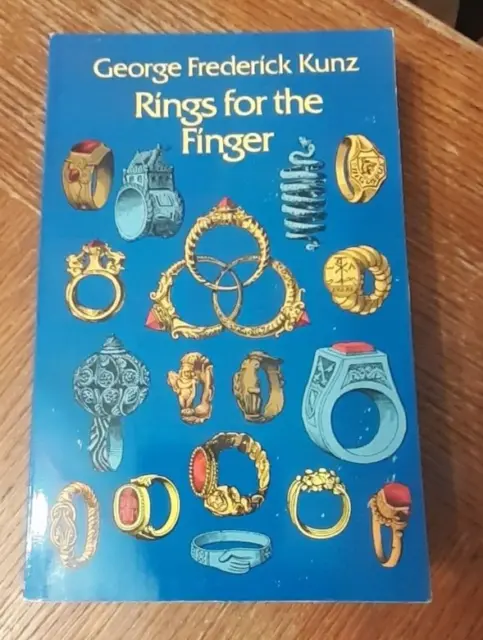
Finger Rings Jewelry History Ancient to Present 290 Pix Roman Medieval Byzantine
$20.00 Buy It Now 14d 1h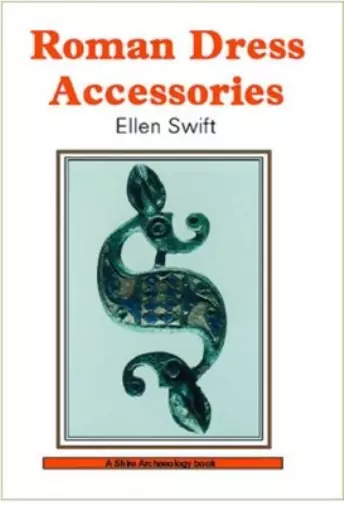
Ellen Swift Roman Dress Accessories (Paperback) Shire Archaeology (UK IMPORT)
$8.85 Buy It Now 1d 18h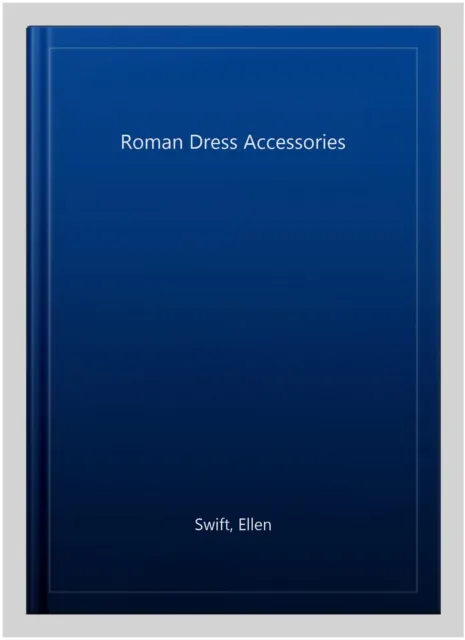
Roman Dress Accessories, Paperback by Swift, Ellen, Like New Used, Free shipp...
$8.50 Buy It Now 30d 21h
Copper and Caribou Inuit Skin Clothing Production Jillian E. Oakes
$18.82 Buy It Now 11d 11h
Roman Warriors - 9781784387198
$32.67 Buy It Now 30d 14h
Roman Agricultural Economy : Organization, Investment, and Production, Paperb...
$44.95 Buy It Now 28d 18h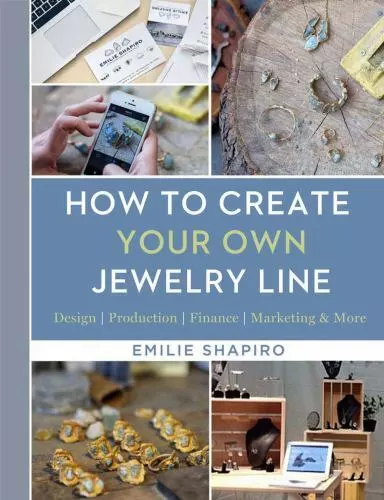
How to Create Your Own Jewelry Line: Design Production Finance Marketing & Mo
$15.89 Buy It Now 19d 22h
Decorated Roman Armour 2017 D'Amato Ancient Rome Military Costume Dress Armor HC
$32.00 Buy It Now 14d 0h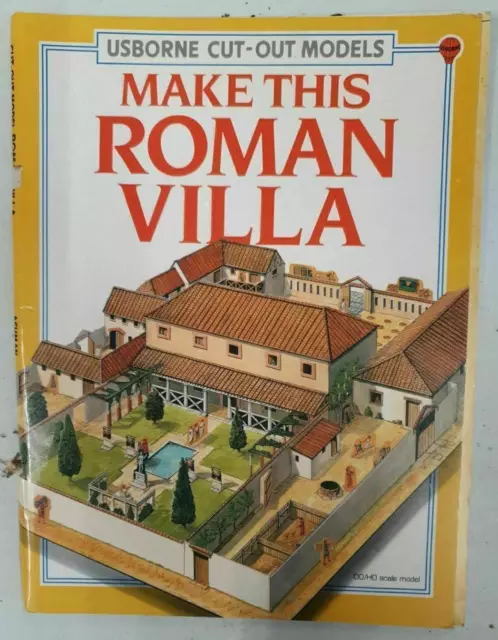
Make This Roman Villa Usborne Cut Out Models RE5
$15.16 Buy It Now 10d 0h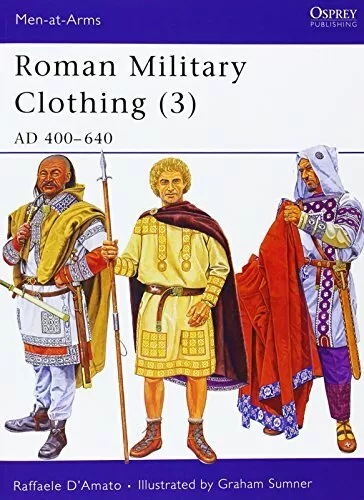
Roman Military Clothing (3): AD 400-640: v. 3 (... by Raffaele D'Amato Paperback
$14.29 Buy It Now 30d 15h
Osprey Men at Arms 374, ROMAN MILITARY CLOTHING (1) 100 BC - AD 200
$19.38 Buy It Now 12d 0h
Greek Roman Hellenic Etruscan Jewelry Trade Production Rings Fibulae 68 ColorPix
$72.99 Buy It Now 21d 2h
Mosaics of the Greek and Roman World - 9780521002301
$52.36 Buy It Now 27d 14h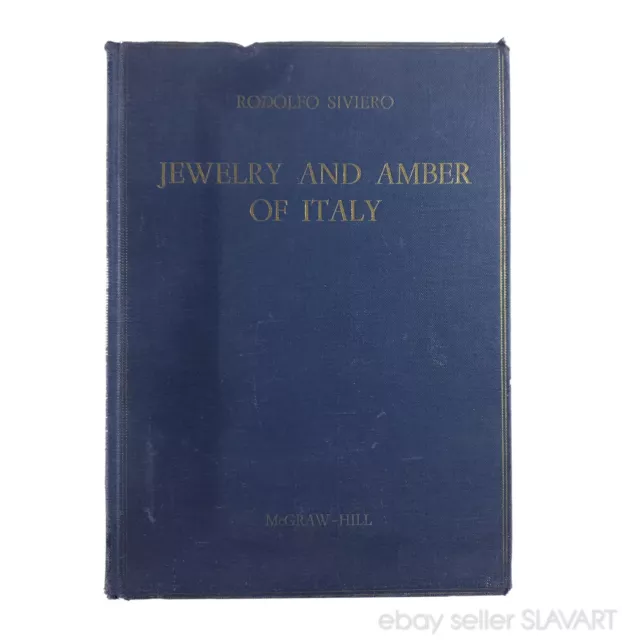
BOOK Jewelry & Amber of Italy 1959 ancient necklace ring medieval cameo fibula
$34.00 Buy It Now 14d 19h
Finger Rings Jewelry History Ancient to Present 290 Pix Roman Medieval Byzantine
$69.99 Buy It Now 12d 20h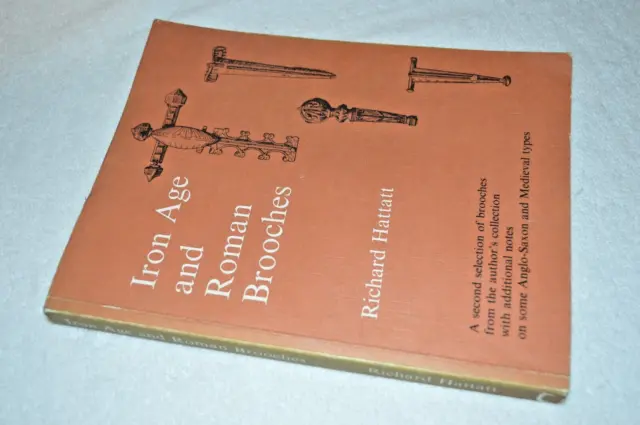
Archaeology - Iron Age And Roman Brooches - 2Nd Selection - Hattatt - 1985
$100.38 Buy It Now 8d 0h
Graham Sumner Roman Military Dress (Paperback) (UK IMPORT)
$32.87 Buy It Now 29d 11h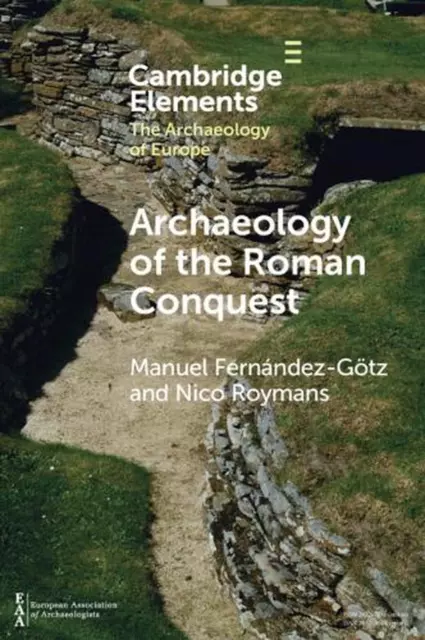
Archaeology of the Roman Conquest: Tracing the Legions, Reclaiming the Conquered
$30.85 Buy It Now 14d 18h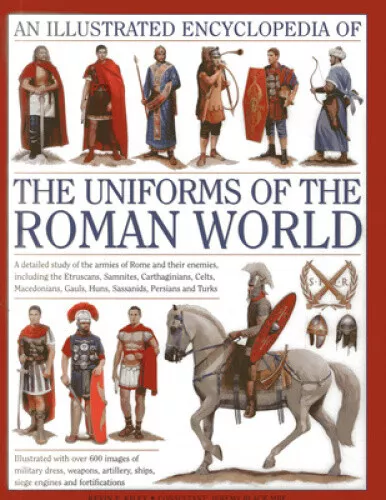
An Illustrated Encyclopedia of the Uniforms of the Roman World: A Detailed
$28.88 Buy It Now 3d 20h
1950 Romanheft Abenteuer Krimi / Rolf Shark Abenteuer in Lyon Bob Barrings
$15.06 Buy It Now 16d 23h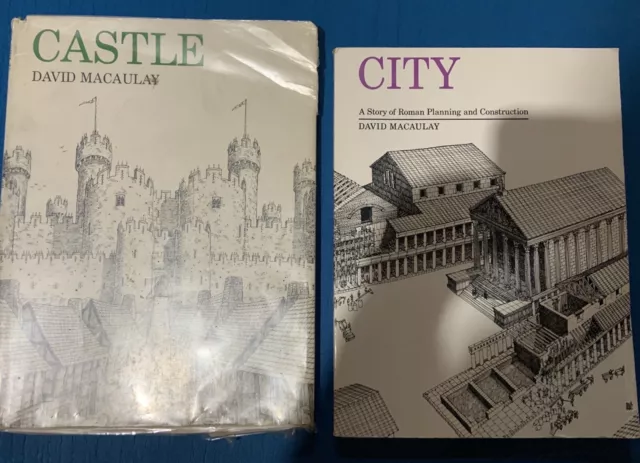
LOT Castle (HB ) And City : A Story of Roman Planning by David Macaulay
$35.00 Buy It Now 26d 21h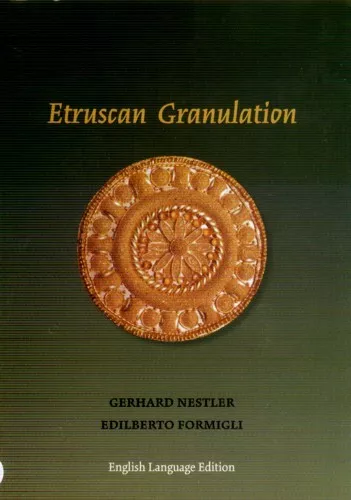
Ancient Etruscan Roman Italy Gold Granulation Jewelry Fibulae Daggers Earrings
$72.99 Buy It Now 12d 20h
16592 Helmut W. Pesch DIE RINGE DER MACHT Roman
$6.74 Buy It Now 13d 7h
The Late Roman Army by Giuseppe Rava (English) Paperback Book
$41.40 Buy It Now 11d 8h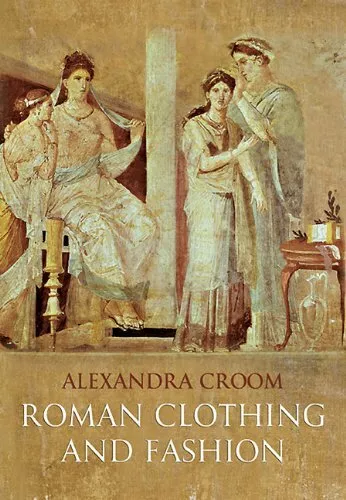
Roman Clothing and Fashion by Croom New 9781848689770 Fast Free Shipping..
$30.12 Buy It Now 3d 14h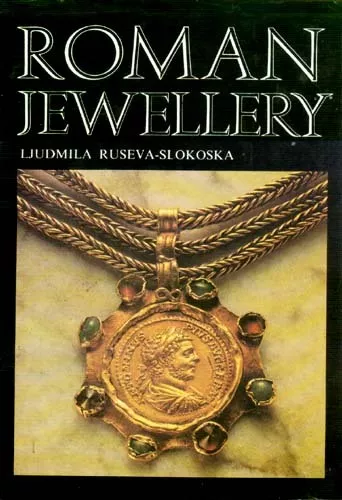
Roman Moesia Thrace Jewelry Rings Earrings Bracelets Torques Pendants Hair Pins
$599.99 Buy It Now 8d 18h
Greek and Roman Jewellery ( Methuens´s Handbooks of Archaeology) Higgins, R. A.:
$65.78 Buy It Now 22d 23h
Post-Roman Kingdoms : 'Dark Ages' Gaul and Britain, AD 450-800 - Elite 248
$17.95 Buy It Now 13d 18h
 Roman Dress Accessories Jewelry Rings Earrings Brooch Pin Belt Fibula Production$47.86 Buy It Now
Roman Dress Accessories Jewelry Rings Earrings Brooch Pin Belt Fibula Production$47.86 Buy It Now 5 watchers
5 watchers Roman Dress Accessories Jewelry Rings Earrings Brooch Pin Belt Fibulae Workshops$47.86 Buy It Now
Roman Dress Accessories Jewelry Rings Earrings Brooch Pin Belt Fibulae Workshops$47.86 Buy It Now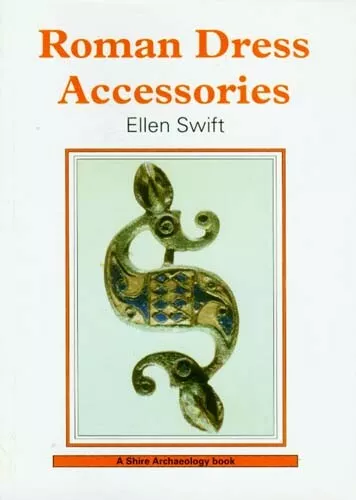 4 watchers
4 watchers Roman Dress Accessories Jewelry Rings Earrings Brooch Fibulae Clothes Production$47.86 Buy It Now
Roman Dress Accessories Jewelry Rings Earrings Brooch Fibulae Clothes Production$47.86 Buy It Now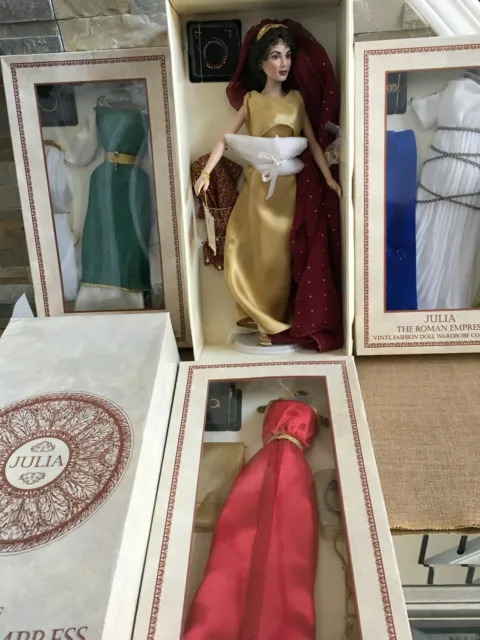 23 watchers
23 watchers Franklin Mint 16" Vinyl Roman Empress JULIA DOLL w/Stand & 3 NRFB ENSEMBLES SET$998.59 Buy It Now
Franklin Mint 16" Vinyl Roman Empress JULIA DOLL w/Stand & 3 NRFB ENSEMBLES SET$998.59 Buy It Now
 Roman Dress Accessories by Alan Wilkins (English) Paperback Book$17.92 Buy It Now
Roman Dress Accessories by Alan Wilkins (English) Paperback Book$17.92 Buy It Now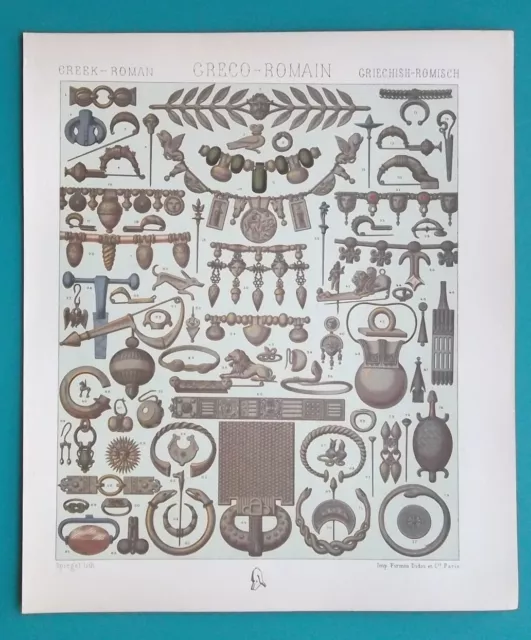 2 watchers
2 watchers JEWELRY Greek Etruscan Fashion Accessories RIngs - COLOR Print by A. Racinet
JEWELRY Greek Etruscan Fashion Accessories RIngs - COLOR Print by A. Racinet$24.62$19.21 Buy It Now or Best Offer 2 watchers
2 watchers Goddess Hair Jewelry Greek Gold Fancy Dress Up Halloween Adult Costume Accessory$18.43 Buy It Now
Goddess Hair Jewelry Greek Gold Fancy Dress Up Halloween Adult Costume Accessory$18.43 Buy It Now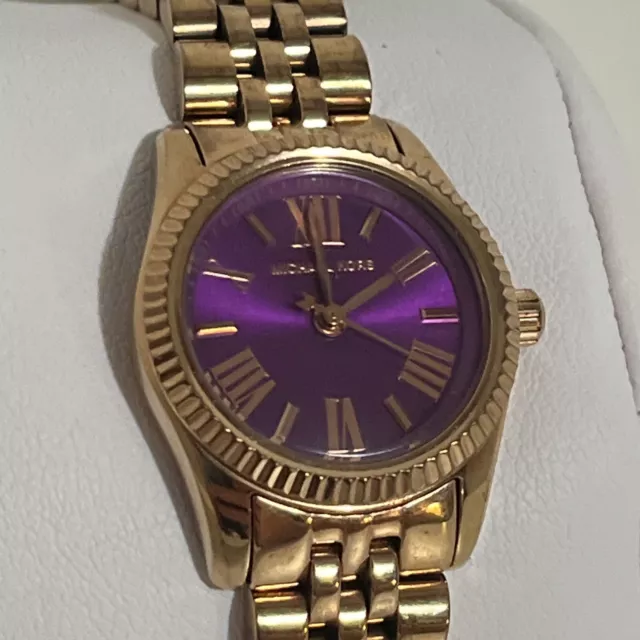 3 watchers
3 watchers Michael Kors Purple Rose Gold Plated MK3273 Petite Lexington Women's Wristwatch$116.28 Buy It Now or Best Offer
Michael Kors Purple Rose Gold Plated MK3273 Petite Lexington Women's Wristwatch$116.28 Buy It Now or Best Offer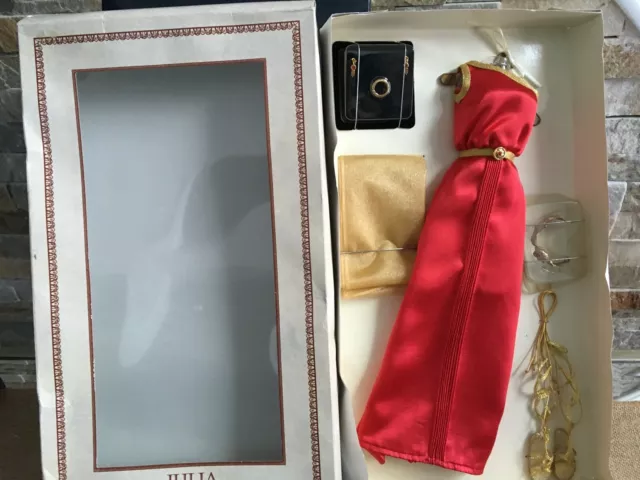 7 watchers
7 watchers Franklin Mint 16"Vinyl Roman Empress JULIA Toy Doll ENSEMBLE clothes outfit NRFB$300.94 Buy It Now
Franklin Mint 16"Vinyl Roman Empress JULIA Toy Doll ENSEMBLE clothes outfit NRFB$300.94 Buy It Now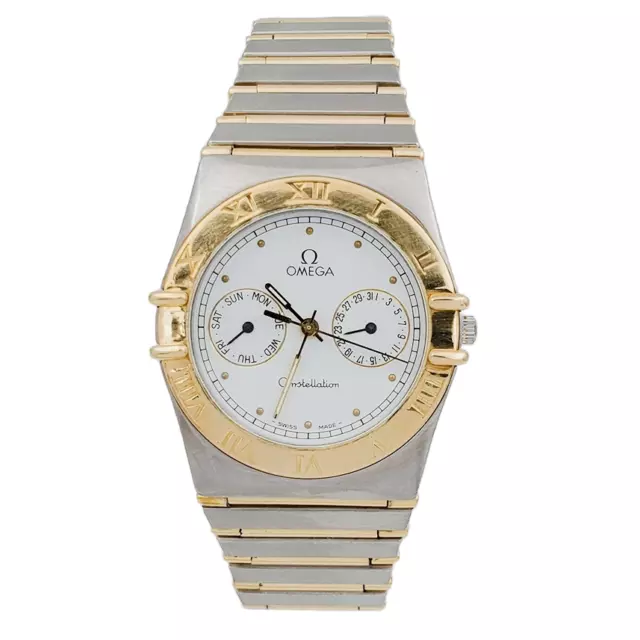 11 watchers
11 watchersMen's Omega 34mm Constellation Chronograph 18K Gold / Steel Watch w/White Dial.
$2,729.06 Buy It Now or Best Offer 1 watcher
1 watcherMen's Omega 33mm Constellation Two Tone 18K Gold / Steel Watch with Gold Dial.
$2,729.06 Buy It Now or Best Offer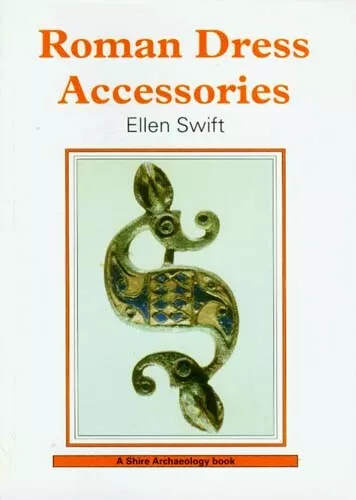 4 watchers
4 watchers Roman Dress Accessories Jewelry Rings Earrings Brooch Clothing Fibulae Workshops$47.86 Buy It Now
Roman Dress Accessories Jewelry Rings Earrings Brooch Clothing Fibulae Workshops$47.86 Buy It Now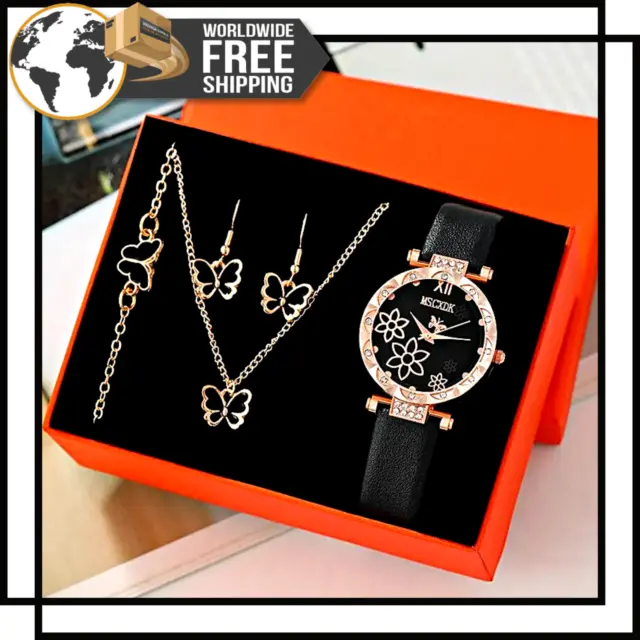
 Womens Black Leather Watch Butterfly Jewelry Luxury Gift Set Quartz Accessories
Womens Black Leather Watch Butterfly Jewelry Luxury Gift Set Quartz Accessories$90.38$85.86 Buy It Now
 Womens Black Watch Bracelets Luxury Accessories Flower Quartz Gift Set Jewelry
Womens Black Watch Bracelets Luxury Accessories Flower Quartz Gift Set Jewelry$90.38$85.86 Buy It Now 1 watcher
1 watcher Retro Unique Double Cover Turntable Capping Hand-Winding Mechanical Pocket Watch$34.20 Buy It Now or Best Offer
Retro Unique Double Cover Turntable Capping Hand-Winding Mechanical Pocket Watch$34.20 Buy It Now or Best Offer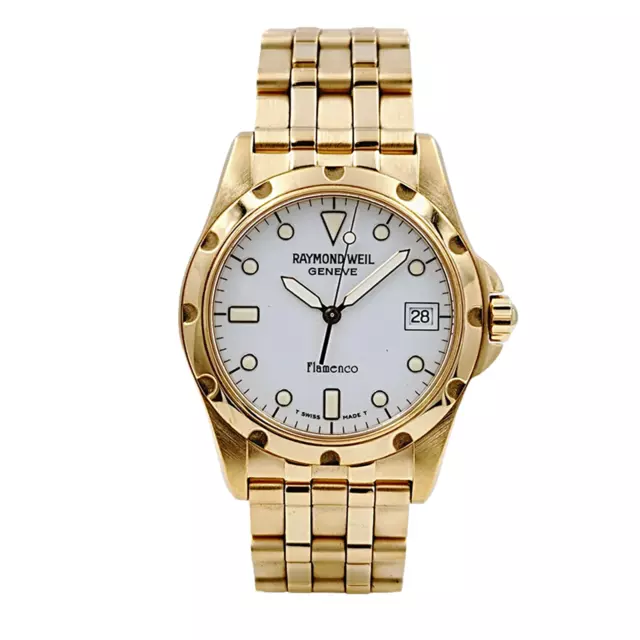 2 watchers
2 watchersMen's Raymond Weil 36mm Flamenco 5570 Gold Plated Watch with White Dial.
$1,771.49 Buy It Now or Best Offer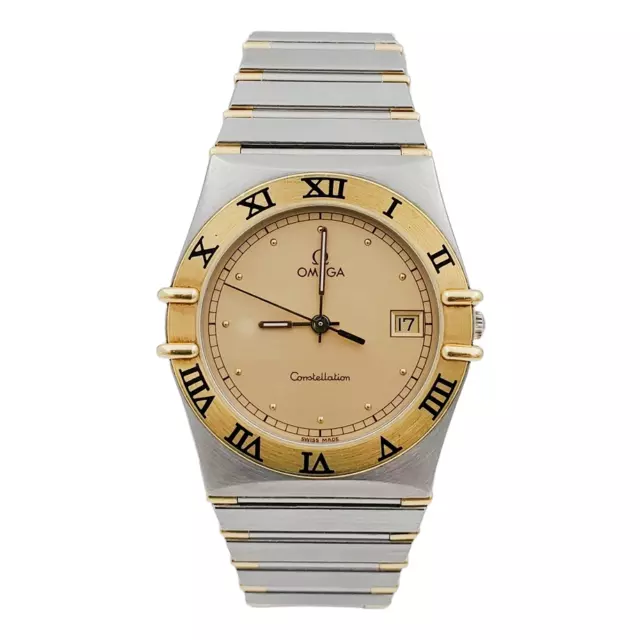 2 watchers
2 watchersMen's Omega 34mm Constellation Two Tone 18K Yellow Gold / Steel Watch.
$3,413.03 Buy It Now or Best Offer
 ACTIVA Swiss Watch Quartz Dial 495494 Water Resistant 30M Analog No Band Women's
ACTIVA Swiss Watch Quartz Dial 495494 Water Resistant 30M Analog No Band Women's$28.37$21.60 Buy It Now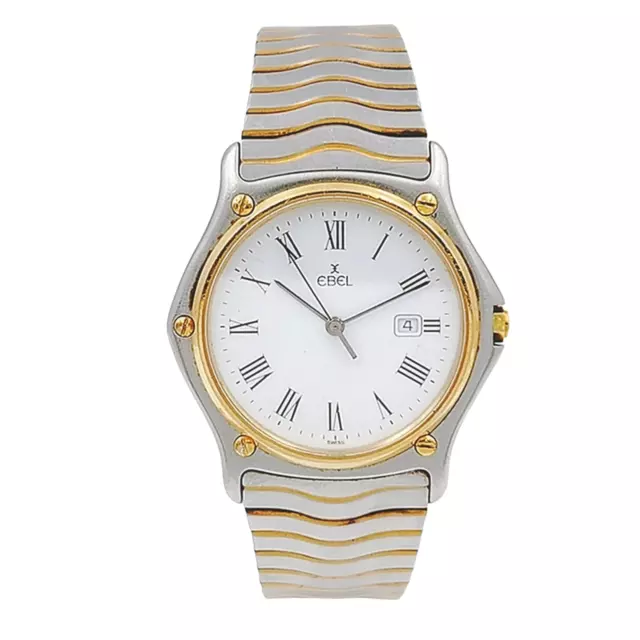
Men's Ebel 34mm 18K Gold / Steel Two Tone Watch with White Roman Numeral Dial.
$2,592.26 Buy It Now or Best Offer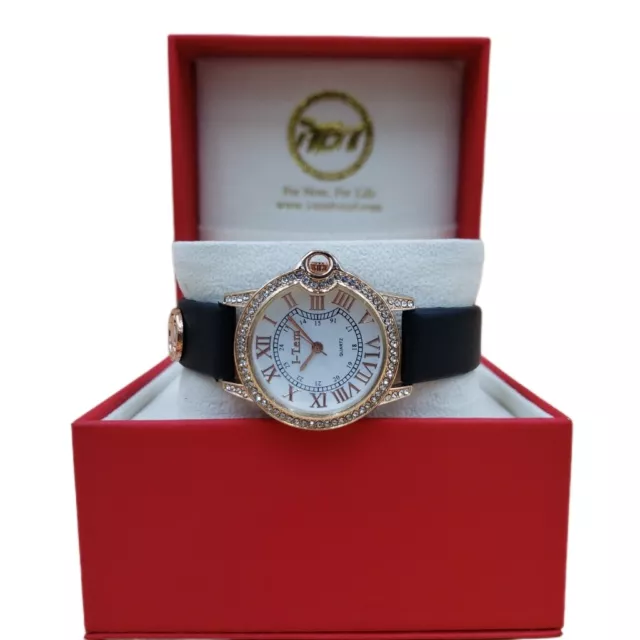
The Sydney Padel I-TW320 Women Fashion Quartz Wristwatch
$47.86 Buy It Now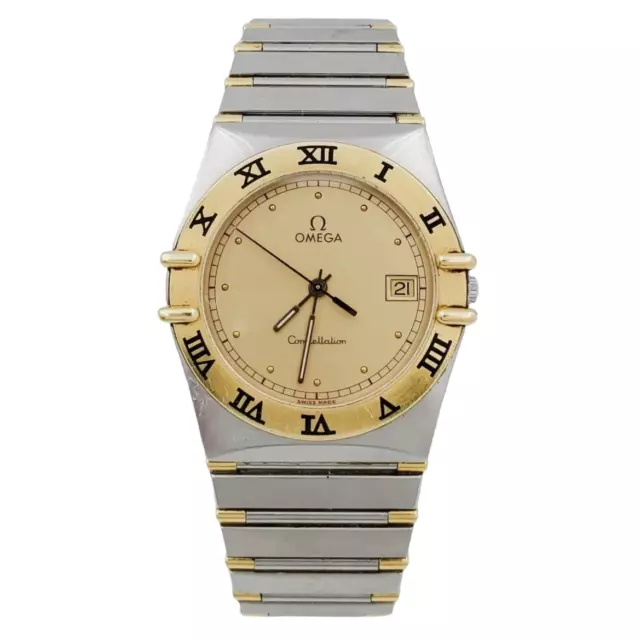
Men's Omega 34mm Constellation Two Tone 18K Gold / Steel Watch with Gold Dial.
$3,413.03 Buy It Now or Best Offer 2 watchers
2 watchersLadies Raymond Weil Tango Stainless Steel Watch with Blue Dial Dial.
$540.34 Buy It Now or Best Offer 1 watcher
1 watcherMen's Ebel 34mm 18K Yellow Gold / Steel Two Tone Watch with Roman Numeral Dial.
$2,592.26 Buy It Now or Best Offer
